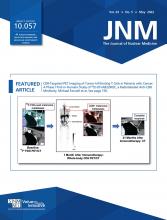
Nuclear medicine is undergoing a renaissance, as evidenced by the steady introduction and approval of new radiopharmaceuticals, theranostics, and instrumentation. In the past year alone, we have celebrated the U.S. Food and Drug Administration (FDA) approval of new PSMA-targeted prostate imaging and therapy agents, breakthrough research for FAPI PET/CT, new generic SPECT agents, and great advances in artificial intelligence. SNMMI has been there every step of the way to support the field of nuclear medicine and molecular imaging, promoting quality of practice, research and discovery, outreach, and advocacy, all while helping ensure an adequate workforce pipeline for the future.
SNMMI strives to enhance the practice of nuclear medicine by providing professionals with the resources needed to deliver high-quality care. In light of recent advances in the field, SNMMI released appropriate use criteria for PSMA PET imaging and musculoskeletal infection imaging, as well as new procedure standards to assist in obtaining high-quality examinations while simultaneously controlling costs. In February, SNMMI launched its Radiopharmaceutical Therapy Center of Excellence program, which offers options for site designation, and later this year will begin its pilot program for the Radiopharmaceutical Therapy Registry (RaPTR), which supports ongoing data collection and quality improvement in theranostics. SNMMI’s Therapeutics Conference, held in March, was well attended and provided education to practitioners wishing to expand their practices to include radiopharmaceutical therapies, such as 177Lu-PSMA-617.
A key SNMMI focus over the past year has been to encourage research. A new initiative, the “Mars Shot” for molecular imaging, focuses on advancing the research and development of diagnostic and therapeutic nuclear medicine. A dosimetry supplement in The Journal of Nuclear Medicine addresses both the rapid progress and challenges in applying patient-specific radiation dosimetry to guide radiopharmaceutical therapies, providing a useful starting point for sites considering implementing dosimetry in their clinical practices or research operations. A therapy toolkit has been developed to assist new sites as they begin research projects. An Artificial Intelligence (AI) Summit was held in March to help drive development of AI tools for nuclear medicine. In addition, the society created and awarded 2 Radiopharmaceutical Therapy Research Fellowships to grow the number of trained investigators in our field.
The society has also been successful in advancing its issues and becoming a valued partner among public policy stakeholders. SNMMI is working hard to encourage legislators and regulators to support and pass the bipartisan Facilitating Innovative Nuclear Diagnostics (FIND) Act, a bill to ensure patient access to nuclear medicine scans (www.snmmmi.org/FindAct). A summit was held in March to educate regulatory representatives about health disparities and barriers to patient access to nuclear medicine procedures. The society has also actively worked to maintain and increase reimbursement for the nuclear medicine community, successfully expanding Centers for Medicare & Medicaid Services coverage for nononcologic PET and 18F-FDG PET for infection and inflammation.
With so much work being done to advance the field, SNMMI realizes the importance of developing a robust pipeline of professionals qualified to practice in all areas of nuclear medicine and molecular imaging, both now and in the future. In the past year, 3 working groups (focused on physicians, scientists, and technologists) were formed to develop content and curricula on radiopharmaceutical therapies and diagnostic procedures for residents. A dedicated resident, medical student, and program director website was also created with tailored content for each group. The society introduced a new education initiative—the Quality Systems Personnel Training Program—to educate individuals with a pharmacy or chemistry background in the production and release of clinical radiopharmaceuticals. SNMMI also launched a new online Career Center which, as of January 2022, has posted more than 2,500 jobs.
Another component of SNMMI’s work is outreach. The society reaches referring physicians through presentations at specialty events, such as the Pediatric Endocrine Society meeting and the San Antonio Breast Cancer Symposium. To connect with patients, SNMMI hosted its annual Patient Education Day, which was attended by 223 participants and has received more than 1,000 on-demand views to date. In-person patient roadshows are scheduled to return in 2022. Two new organizations joined SNMMI’s Patient Advisory Board in 2021, bringing the total number of participants to 15. Internationally, SNMMI’s Department of Energy Grant Taskforce continues to work closely with the Korle Bu Teaching Hospital in Accra, Ghana, to assist in building its nuclear medicine program.
As always, SNMMI supports nuclear medicine and molecular imaging through its meetings and journals. Held virtually last year, the 2021 Annual Meeting welcomed more than 6,000 participants from more than 60 countries, with an expanded scientific program including 80 continuing education and scientific sessions, 189 scientific oral presentations, 14 satellite symposia, 1,000 scientific posters, and 115 exhibitors. The Journal of Nuclear Medicine continues to promote innovative research and dramatically increased its impact factor last year, now ranking third among all medical imaging journals.
In the fall of 2021 SNMMI kicked off a new consumer-focused public relations initiative to raise awareness about what nuclear medicine is and what it can accomplish. By focusing on consumer broadcast media—print and digital news publications, radio, and TV—SNMMI has been able to reach a broad audience, including patients, referring physicians, legislators, regulators, payers, and other media. After only 6 months, the program has provided content to a potential 1 billion consumers.
SNMMI is stable, financially secure, and ready to lead in a new era of nuclear medicine and molecular imaging. As the nuclear medicine renaissance continues, the society is committed to our members and the patients we serve.
- © 2022 by the Society of Nuclear Medicine and Molecular Imaging.







